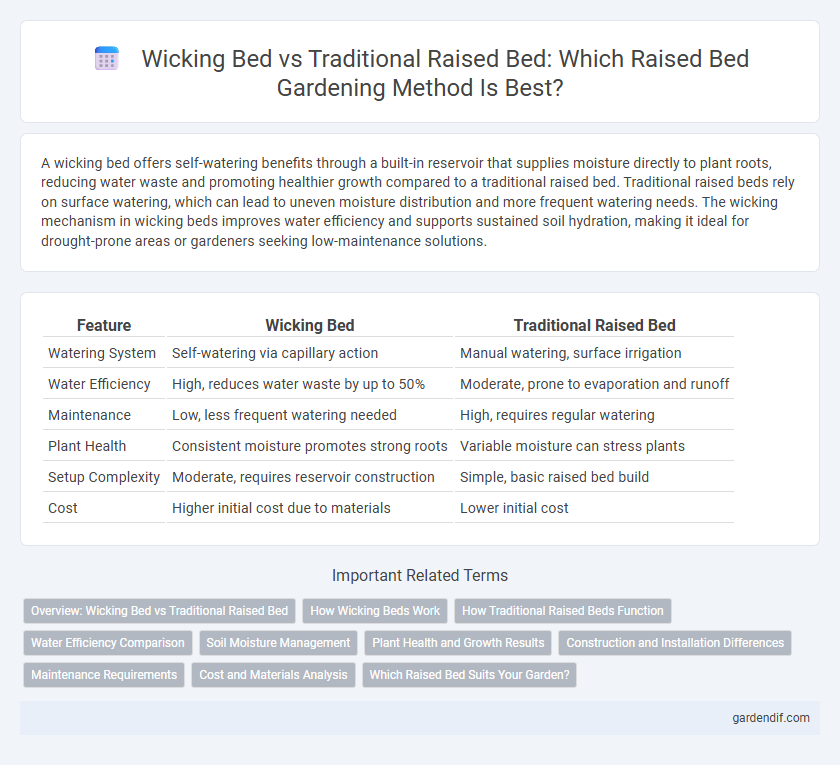
Wicking Bed vs Traditional Raised Bed Illustration
A wicking bed offers self-watering benefits through a built-in reservoir that supplies moisture directly to plant roots, reducing water waste and promoting healthier growth compared to a traditional raised bed. Traditional raised beds rely on surface watering, which can lead to uneven moisture distribution and more frequent watering needs. The wicking mechanism in wicking beds improves water efficiency and supports sustained soil hydration, making it ideal for drought-prone areas or gardeners seeking low-maintenance solutions.
Table of Comparison
| Feature | Wicking Bed | Traditional Raised Bed |
|---|---|---|
| Watering System | Self-watering via capillary action | Manual watering, surface irrigation |
| Water Efficiency | High, reduces water waste by up to 50% | Moderate, prone to evaporation and runoff |
| Maintenance | Low, less frequent watering needed | High, requires regular watering |
| Plant Health | Consistent moisture promotes strong roots | Variable moisture can stress plants |
| Setup Complexity | Moderate, requires reservoir construction | Simple, basic raised bed build |
| Cost | Higher initial cost due to materials | Lower initial cost |
Overview: Wicking Bed vs Traditional Raised Bed
Wicking beds use a water reservoir beneath the soil to provide consistent moisture through capillary action, reducing water usage compared to traditional raised beds that rely on surface watering. Traditional raised beds offer superior drainage and are simpler to build but require more frequent watering and soil moisture management. Wicking beds are ideal for drought-prone areas or gardeners seeking low-maintenance irrigation, whereas traditional beds suit gardeners who prioritize ease of soil amendment and drainage control.
How Wicking Beds Work
Wicking beds utilize a water reservoir beneath the soil that delivers moisture directly to plant roots through capillary action, optimizing water efficiency. Traditional raised beds rely on surface watering, which often leads to uneven moisture distribution and increased evaporation. The self-watering mechanism in wicking beds reduces irrigation frequency and supports healthier plant growth by maintaining consistent soil moisture levels.
How Traditional Raised Beds Function
Traditional raised beds function by elevating soil above ground level, improving drainage and soil structure for better root growth. They rely on manual watering, with water often applied at the surface and absorbed downward, which can lead to uneven moisture distribution. Nutrient management requires periodic amendments as nutrients may leach out due to surface watering and exposure.
Water Efficiency Comparison
Wicking beds use a self-watering system where water is stored at the base and wicked up to plant roots, reducing water waste by up to 70% compared to traditional raised beds that rely on surface watering. Traditional raised beds often lose water through evaporation and runoff, making them less efficient in water use. The controlled moisture environment in wicking beds supports consistent plant hydration and minimizes irrigation frequency.
Soil Moisture Management
Wicking beds excel in soil moisture management by incorporating a water reservoir beneath the soil, enabling consistent capillary action that supplies moisture directly to plant roots. Traditional raised beds rely on surface watering, which often results in uneven moisture distribution and increased evaporation. This makes wicking beds more efficient for water conservation and maintaining optimal soil hydration levels.
Plant Health and Growth Results
Wicking beds provide consistent moisture directly to plant roots, reducing water stress and promoting robust root development compared to traditional raised beds. The self-watering mechanism maintains optimal soil moisture levels, resulting in improved nutrient uptake and faster plant growth. Studies show that crops in wicking beds often exhibit higher yields and healthier foliage due to superior water efficiency and reduced risk of over- or under-watering.
Construction and Installation Differences
Wicking beds are constructed with a water reservoir at the base, allowing soil moisture to be drawn up through capillary action, which necessitates waterproof lining and overflow outlets during installation. Traditional raised beds consist of simple soil-filled frames without water reservoirs, making their construction direct and reliant on external watering methods. Installation of wicking beds requires careful leveling and reservoir filling, while traditional beds prioritize soil preparation and drainage.
Maintenance Requirements
Wicking beds require less frequent watering compared to traditional raised beds due to their self-watering system that delivers moisture directly to plant roots. Traditional raised beds demand more regular irrigation and monitoring to prevent soil from drying out and to maintain optimal plant health. Wicking beds also reduce weeding and soil depletion, lowering overall maintenance requirements significantly.
Cost and Materials Analysis
Wicking beds typically incur higher initial costs due to the need for a waterproof liner, water reservoir components, and specialized soil mixtures compared to traditional raised beds, which require only basic materials like wood or metal frames and garden soil. The materials for wicking beds include durable liners such as pond liners or heavy-duty plastic, along with gravel or drainage layers to facilitate water retention, whereas traditional raised beds rely on standard soil and mulch without built-in irrigation systems. Long-term water savings and reduced maintenance in wicking beds potentially offset upfront expenses, making them a cost-effective solution in water-scarce regions, unlike traditional beds that often demand frequent manual watering and soil replenishment.
Which Raised Bed Suits Your Garden?
Wicking beds offer self-watering capabilities through a reservoir that provides consistent moisture, making them ideal for drought-prone areas and water-efficient gardening. Traditional raised beds rely on regular watering and are better suited for gardeners who prefer simpler construction and less initial investment. Choosing between a wicking bed and a traditional raised bed depends on your garden's water availability, maintenance preferences, and local climate conditions.
Wicking Bed vs Traditional Raised Bed Infographic

 gardendif.com
gardendif.com